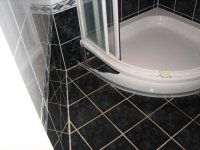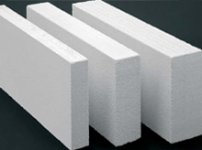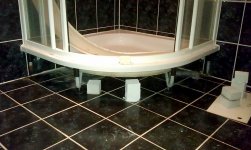AlexThePalex
Member
- Joined
- Nov 12, 2008
- Messages
- 7,808
Guys, I have two questions about a small job I have to do with some Ytong blocks (dutch: cellenbeton), maybe known to some people as Durox, and wikipedia tells me in English it's called autoclaved aerated concrete. I have little experience with this type of material and lack the proper tools.
[attachimg=2]
I have to repair a plastic profile underneath a shower tub that's broken, and best option to me seems to replace it with Ytong blocks and tile it over. Unfortunately, it wasn't possible to order a new profile so I have to improvise.
[attachthumb=1]
My idea is to cut 4 of these blocks so they follow the rounding and then finish it off with tiles.
So here's my first question, as always, people expect me to do these kind of jobs as economically as possible, so I was wondering what's the cheapest way to cut these blocks. I know there are saws with HM teeth for it, but buying one for just 4 blocks seems a bit overkill, and now I'm wondering if it is possible to cut them with my jigsaw and what would be the best type of blade to use.
Second, I need to glue the blocks to the existing tile floor, and I was wondering what the best, and again, most economical way to do this would be. I know there is special glue for these blocks, but I've heard you can also use mortar, and I was wondering if the thinset for the tiles would also work as that's a kind of mortar, isn't it? Would the blocks properly stick together and to the tiles if I used thinset?
Thanks in advance for any insight you can offer me.
[attachimg=2]
I have to repair a plastic profile underneath a shower tub that's broken, and best option to me seems to replace it with Ytong blocks and tile it over. Unfortunately, it wasn't possible to order a new profile so I have to improvise.
[attachthumb=1]
My idea is to cut 4 of these blocks so they follow the rounding and then finish it off with tiles.
So here's my first question, as always, people expect me to do these kind of jobs as economically as possible, so I was wondering what's the cheapest way to cut these blocks. I know there are saws with HM teeth for it, but buying one for just 4 blocks seems a bit overkill, and now I'm wondering if it is possible to cut them with my jigsaw and what would be the best type of blade to use.
Second, I need to glue the blocks to the existing tile floor, and I was wondering what the best, and again, most economical way to do this would be. I know there is special glue for these blocks, but I've heard you can also use mortar, and I was wondering if the thinset for the tiles would also work as that's a kind of mortar, isn't it? Would the blocks properly stick together and to the tiles if I used thinset?
Thanks in advance for any insight you can offer me.





